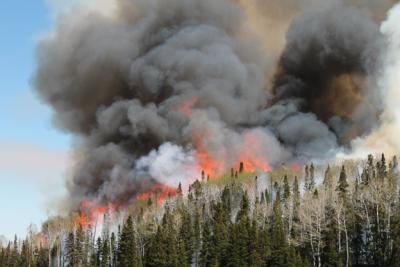Particulates, Fire Emissions Projected to Increase Due to Climate Change
In recent decades, wildfire burn area in the United States has tripled, increasing the amount of fine particulate matter (PM2.5) in the air. Using future meteorological and vegetation projected by climate models and explainable artificial intelligence (XAI), which helps interpret predictions made by machine learning models, scientists found a four to 75 percent increase in PM2.5 emissions in the mid-century that was driven by higher temperature and soil dryness. Land use changes have also amplified emissions 58 to 83 percent in the western United States, primarily due to increased vegetation growth which provides more potential fuels for fires.
The frequency and severity of wildfires have significantly risen, and researchers can use XAI to project future fire emissions and pinpoint the key drivers with computational efficiency and physical explanations. This study underscores the growing risks of wildfire-related air pollution in the coming decades and emphasizes the critical role of land management in mitigating wildfire impacts under climate change.
Climate change has increased the frequency and size of fires in the western United States, causing property damage, threats to human life, and degraded air quality. Frequent drought, enhanced fuel aridity, and increased fuel accumulation may cause larger and more frequent fires and emissions in the coming decades. Using XAI and projections of meteorological and vegetation changes from global climate models, Pacific Northwest National Laboratory researchers show that total fire PM2.5 emissions over the contiguous US will be around 1.38 times the present-day emissions by the mid-21st century under a high greenhouse gas emissions scenario. The fire PM2.5 emissions will double in the western US during summer, mainly driven by drying trends in the soil along with increasing temperatures. When the future change of land use and land cover is also considered, the fire emissions in the western US will increase further by 50 percent, due to the increased vegetation fractions in a warmer climate.

